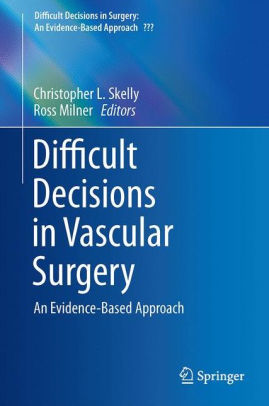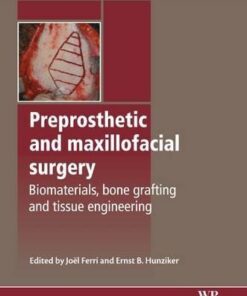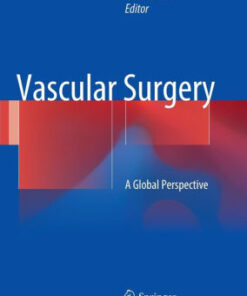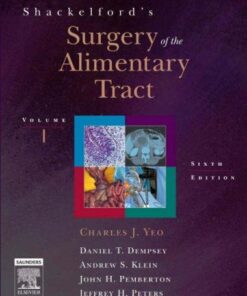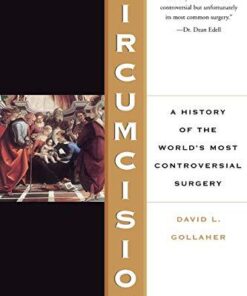(eBook) Difficult Decisions in Vascular Surgery by Christopher L. Skelly
$22.00
Download instantly Difficult Decisions in Vascular Surgery – An Evidence-Based Approach by Christopher L. Skelly, Ross Milner. It is ebook in PDF format.
ISBN-10: 3319332910 ISBN-13: 9783319332918
Preview
This is the PDF eBook version for Difficult Decisions in Vascular Surgery – An Evidence-Based Approach by Christopher L. Skelly, Ross Milner
Table of Contents
Section 1: Aortic Disease
Ch. 1: In patients with Acute Type B Aortic dissection, do current operative therapies reduce complications compared to medical management?
Ch. 2: In patients with a Chronic Type B dissection, does Endovascular treatment reduce long term complications?
Ch.3: In patients with a retrograde Type A Aortic dissection, does treatment like a type B Aortic dissection improve outcomes?
Ch.4: In patients with small AAA, does medical therapy prevent growth?
Ch.5: Challenging AAA Neck Anatomy: Does the Fenestrated or Snorkel/Chimney Technique Improve Mortality and Freedom from Reintervention Relative to Open Repair?
Ch.6: In patients who require Hypogastric artery coverage to treat an AAA with EVAR, does preservation improve outcomes when compared to exclusion of the vessel?
Ch.7: In patients with aortic graft infections, does EVAR improve long term survival compared to open graft resection?
Ch.8: Does EVAR improve outcomes or quality of life in patients unfit for open surgery?
Ch.9: In patients with type 2 endoleaks does intervention reduce aneurysm related morbidity and mortality compared to observation?
Ch.10: Ruptured Abdominal Aortic Aneurysm Treated with Endovascular Repair; Does Decompressive Laparotomy Result in Improved Clinical Outcomes?
Ch.11: In a Patient with Blunt Traumatic Aortic Injury, Does TEVAR Improve Survival Compared to Open Repair or Expectant Management?
Section 2: Lower Extremity Arterial Disease
Ch.12: In patients with Aortoiliac occlusive disease, does Endovascular repair improve outcomes when compared to open repair?
Ch.13: In Patients with Aortoiliac Occlusive Disease, Does Extra-anatomic Bypass Improve Quality of Life and Limb Salvage?
Ch.14: In Patients with Critical Limb Ischemia Does Bypass Improve Limb Salvage and Quality of Life When Compared to Endovascular Revascularization?
Ch.16: In the patient with Profunda artery disease, is open revascularization superior to endovascular repair for improving rest pain?
Ch.17: In patients with limb-threatening vascular injuries, is there a role of prophylactic fasciotomy to reduce ischemic injury?
Ch.18: In patients with Popliteal Entrapment Syndrome, does surgery improve quality of life?
Section 3: Mesenteric Disease
Ch.19: In patients with Acute Mesenteric Ischemia does an endovascular or hybrid approach improve morbidity and mortality compared to open revascularization?
Ch.20: Chronic Mesenteric Arterial Disease
Does an endovascular/hybrid approach improve morbidity and mortality as compared to open revascularization?
Ch.21: In patients with mesenteric ischemia is single vessel reconstruction equivalent to multiple vessel revascularization?
Ch.22: In patients with celiac artery compression syndrome, does surgery improve quality of life?
Ch.23: In patients with the Superior Mesenteric Artery syndrome is Enteric Bypass superior to Duodenal Mobilization
Ch.24: In patients with Renovascular hypertension is there a role for open or endovascular revascularization compared to medical management?
Ch.25: Does endovascular repair reduce the risk of rupture compared to open repair in splanchnic artery aneurysms?
Section 4: Cerebrovascular Disease
Ch.26: In patients with asymptomatic carotid artery stenosis does current best medical management reduce the risk of stroke compared to intervention (endarterectomy or stent)?
Ch.27: In patients with symptomatic carotid artery stenosis is endarterectomy safer than carotid stenting?
Ch.28: In Patients Undergoing Carotid Endarterectomy, is the Eversion Technique Superior to a Patch Technique to Reduce Restenosis?
Ch.29: In patients with a stroke attributable to a carotid artery stenosis, does waiting to operate reduce the risk of complications?
Ch.30: In patients with a peri-procedural cerebral thromboembolism,
Does Neurovascular rescue improve Clinical Outcome?
Ch.31: In patients with extra-cranial carotid artery aneurysms, does an endovascular approach improve clinical outcomes compared to open repair?
Ch.32: In Patients with Carotid Artery Dissection, is Stenting Superior to Open Repair to Improve Clinical Outcomes?
Ch.33: In patients with cervico-thoracic vascular injuries is endovascular repair superior in long-term durability when compared to open repair?
Section 5: Venous and Arteriovenous Disease
Ch.34: In Patients with Iliofemoral Deep Vein Thrombosis Does Clot Removal Improve Functional Outcome when Compared to Traditional Anticoagulation?
Ch.35: In morbidly obese patients undergoing major abdominal operative procedures, does inferior vena cava filter placement prevent massive PE?
Ch.36: In patients with chronic venous stenosis, does placement of a stent improve patency compared to recurrent angioplasty?
Ch.37: In Patients with Chronic Venous Ulcer is the Unna Boot Still the Best Approach to Wound Care
Ch.38: In Patients with Threatened or Occluded Access Grafts, Is it Better to Salvage the Graft, or Create a New Site?
Ch.39: In patients with new arteriovenous fistulas, are there effective strategies to enhance AVF maturation and durability beyond waiting?
Section 6: Perio-operative Management
Ch.40: In patients with cardiovascular disease, do statins alone, or in combination with other medications improve mortality?
Ch.41: In patients who have undergone a lower extremity bypass for PAD, does dual anti-platelet therapy improve outcomes?
Ch.42: In patients undergoing vascular surgery, does preoperative coronary revascularization reduce the risk of myocardial infarction and death?
